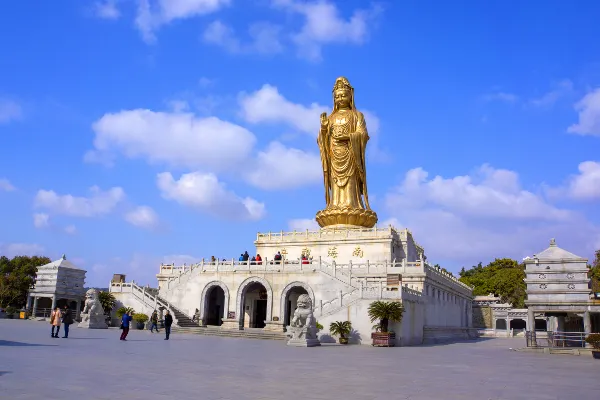
Located in Putuo District, Zhoushan City, Zhejiang Province, Putuo Mountain is one of China's Four Sacred Buddhist Mountains and a national 5A-level tourist attraction. Covering 12.5 square kilometers with its highest peak Foding Mountain at 291.3m, it hosts 43 temples including the Three Great Monasteries (Puji, Fayu, Huiji) and 108 nunneries, creating a unique Buddhist landscape where "temples hide in every mountain bend, monks appear when paths seem to end".
History and Culture
Buddhist history began in Tang Dynasty when Japanese monk Hui'e enshrined a Guanyin statue here in 916 AD, founding the "Temple of Unwilling Departure". Designated as Guanyin Bodhisattva's sacred site in Song Dynasty, it became one of Four Buddhist Mountains. Reaching peak prosperity during Ming-Qing periods under imperial patronage, it formed the hierarchy: "Golden Wutai, Silver Putuo, Bronze Emei, Iron Jiuhua".
Over millennia, Putuo integrated Han Buddhism with maritime culture. The oldest structure is Yuan Dynasty's Duobao Pagoda. Ming anti-pirate hero Qi Jiguang built defenses here. Modern masters like Xuyun and Yinguang propagated Dharma here, establishing Putuo as a key Han Buddhism practice site.
Main Attractions
Puji Chan Monastery
The premier monastery established in 1080 AD, covering 37,000㎡. Its Mahavira Hall houses an 8.8m-tall Vairocana Guanyin statue under Ming Dynasty Nine-Dragon Ceiling. The lotus-filled Haiyin Pond outside creates "Moonlit Lotus Pond", top of Putuo's Twelve Scenes.
Nanhai Guanyin Statue
A 33-meter bronze statue completed in 1997. The face contains 96 taels of gold, facing East Sea with Dharma wheel. The base houses exhibition of historical Guanyin statues. This vantage point offers views of Luojia Mountain's reclining Buddha formation.
Fayu Chan Monastery
Second largest monastery features Nine-Dragon Hall relocated from Forbidden City by Kangxi Emperor. Its golden Ming-era ceiling is China's best-preserved. Ancient cypress trees and bronze tripods are cultural treasures. "Buddhist Kingdom on Sea and Sky" cliff carving was inscribed by Ming general Hou Jigao.
Thousand-Step Sands
A 1,750-meter premium golden sand beach with fine texture. At dawn witness the "Sun Rising from Waves", at dusk admire the "Lotus Ocean Ferry", and at night listen to the "Sound of Waves Along the Sands". The northern end features "Teacher Rock" carved with Buddhist wisdom "Repentance is the Shore", a favorite photography spot.
Cuisine
Putuo Vegetarian Cuisine
Monastery vegetarian dishes feature "meat imitation with vegetarian ingredients". Fayu Temple's vegetarian banquet is most renowned. Recommended: Vegetarian "Goose", Buddhist Mixed Vegetables, Putuo Buddha Cakes. Using local mountain herbs and seaweed, following Buddhist "no food after noon" precepts.
Guanyin Cakes
Traditional pastries filled with black sesame, peanuts or seaweed, imprinted with lotus patterns. Puji Temple's original recipe cakes stay fresh for 15 days, ideal as Buddhist offerings or souvenirs.
Zhoushan Seafood Noodles
Handmade rice noodles with freshly caught East Sea seafood. Recommended "Three Delicacies Noodles" at Shenjiamen Night Market featuring yellow croaker, mantis shrimp and clams in sweet broth with chewy noodles.
Ticket Information
Peak season (Feb-Nov): 160 yuan/person; Off-season (Dec-Jan): 120 yuan. Three Great Monasteries incense tickets 5 yuan each, Nanhai Guanyin Statue 6 yuan. Cable car: 40 yuan one-way, 70 yuan round-trip. Free for children under 1.2m, seniors over 70, and monks; students half-price with ID.
Recommended Itinerary
Classic pilgrimage route: Day1 Pier→Dugu Sacred Site→Nanhai Guanyin→Purple Bamboo Grove→Unwilling-to-Leave Guanyin Temple→Puji Temple→West Heaven Scenic Area; Day2 Foding Summit Huiji Temple→Fayu Temple→Thousand-Step Sands→Fanyin Cave. Extended tours can add Luojia Mountain cruise (additional ticket required).
Transportation
- Ferry: 15-minute speedboat from Zhujiajian Wugongzhi Pier
- Bus: Island shuttle buses to major temples (5-10 yuan)
- Driving: Park at Zhujiajian lot and transfer to ferry
- Flight: Zhoushan Putuo Airport is 10 minutes from Wugongzhi Pier
Must-Visit Attractions
- Nanhai Guanyin Statue - 33m bronze icon of Putuo
- Puji Chan Monastery - Millennium-old exemplar of Han Buddhism
- Thousand-Step Sands - East China's finest sunrise beach
- Huiji Temple on Foding Summit - Highest temple with sea-of-clouds mirages
- Fanyin Cave - Natural sea-eroded grotto for tidal meditation
Travel Tips
- Best visiting April-October, avoiding typhoon season (July-September)
- Wear comfortable anti-slip shoes for temple stairs
- Prepare small change for incense offerings (large bills discouraged)
- Stay near Puji Temple for convenient morning/evening ceremonies
- Purchase "Auspicious Incense" only at authorized Buddhist shops
- Allow 2-3 days for immersive cultural experience
Precautions
- No photography inside temple halls; maintain silence
- Offer three incense sticks maximum; don't blow out flames
- Watch steps on slippery coastal rocks; heed tide warnings
- Protect ecosystem - no feeding animals in liberation ponds
- Respect monks - don't touch ritual objects or statues
- Book ferry tickets and accommodation early during peak seasons
